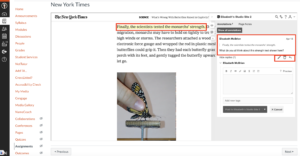 The Ecampus multimedia team researches emerging tools, and works with our sibling team of Instructional Designers to help support instructors. So lets take a moment to peek at tools we all might be using in the coming years for communicating with teammates from a distance.
The Ecampus multimedia team researches emerging tools, and works with our sibling team of Instructional Designers to help support instructors. So lets take a moment to peek at tools we all might be using in the coming years for communicating with teammates from a distance.
Multimedia developers primarily use a paid tier of Slack (for instant messaging), Outlook (for email), and Zoom (for meetings with live video or audio). While we play around with many other emerging tools, I believe we’re using the same basic trio as most everyone else. Just wanted to be clear that I don’t have a revolutionary new secret tool in my back pocket which you must start using today. We’re all in the same basic boat at the moment.
CDT shares files through a variety of different online services. Documents are usually shared through Box, with Google Drive as a backup. Videos usually end up on Kaltura through OSU’s MediaSpace, but works in progress start out on Frame.io to leverage some handy features for time stamped feedback. We manage our team’s projects through Asana, and store final deliverable files with a wrap-up note in a private internal database tool (that our team created and maintains). So those are handful of tools that might be mentioned when working with us. You may have already been sent a Box folder to upload files into, or a frame.io link to comment on a video.
As we all settled into home office work back in March, there was an interest in new tools for social interaction. I was particularly interested in applications that were connecting Virtual Reality users with phone and desktop users. Mozilla, the creators of the Firefox browser, are quietly building up Hubs, which strikes me as the most promising tool in this space. It’s free, easy to learn, and offers a ton of excellent functionality. Stop by the experimental space I set up for my team. It features a 3D model imported from our sketchfab account, and a video from our YouTube account.
One of the developers of Hubs recently laid out the secret plan for this tool: to build up a persistent global 3D network to rival the world wide web. Exciting stuff for all you fans of the scifi metaverse, and the freedom of early web pages.
There are other interesting tools bubbling around at the moment in the VR space. Facebook is letting anyone sign up for the beta of a shared social universe for Oculus VR users called “horizon.” Microsoft acquired AltspaceVR, which mixes VR users with desktop users and has already hosted multiple conferences during the quarantine. If you’ve invested in a VR headset, it might be worth checking out the bustling communities in VR chat or Rec Room. The makers of Second Life tried out 2 approaches to VR (Sansar and High Fidelity), but recently changed course. My team is currently trying to schedule a time to try out Sketchbox in different VR headsets. I stumbled across “Somnium Space” while writing this blog post. It’s kind of crazy how many things are being developed, but… aren’t quite ready for mass consumption just yet.
There is a cognitive load problem with all the new tools bubbling up in these cauldrons around the world and begging for attention. While Mozilla Hubs is my favorite, it does take a few minutes to go through it’s tutorial and learn what all you can do. These days that’s a lot to ask of people who just seek the simplicity of walking into a room to meaningfully interact with other humans in a natural way. More and more I’m nervous about suggesting new tools to colleagues, because I know they’re already dealing with a lot. And I see a lot of folks casually making a notable pile of work for others without seeming to notice the strain. As a designer, I enjoy walking through a new tool, and once I determine it’ll be useful for others it is hard to appreciate how exhausting it might also be for them. I think the key mistake is to require others learn a tool before they can get back to whatever task they set out to do in the first place. Hopefully we can find ways to design simpler tools, and to help people enjoy learning useful new third party tools. Wait until you’re ready to jump into the ones I’m mentioning here, and take it easy on your coworkers.
Suggestions? Want to meet up and talk about this further, perhaps inside one of the tools mentioned above? Please just leave a comment, or send us an email – we’d love to hang out with you and explore what the world is cooking up!





 For DIY video production, there are many ways to go about this!
For DIY video production, there are many ways to go about this!





 Difficult Conversations
Difficult Conversations